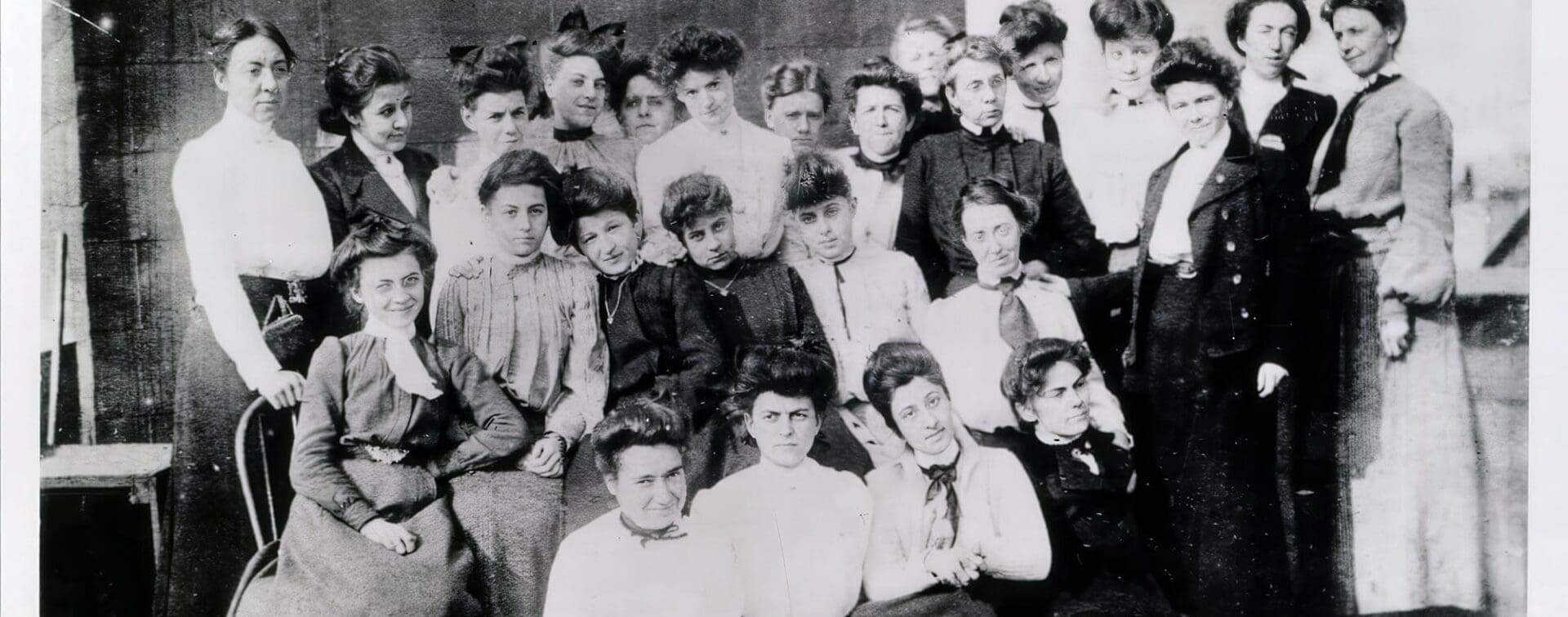Tiffany’s Secret Women: The Forgotten “Tiffany Girls”
At the turn of the 20th century, Louis Comfort Tiffany’s vibrant stained-glass lamps, windows, and jewelry became icons of American Art Nouveau. Yet behind these masterpieces was a team of talented women—known as the “Tiffany Girls”—whose names remained largely unknown for decades. These women artists selected glass, cut intricate patterns, and even designed many of Tiffany’s most celebrated works.
Meet the Women Who Shaped Tiffany’s Legacy
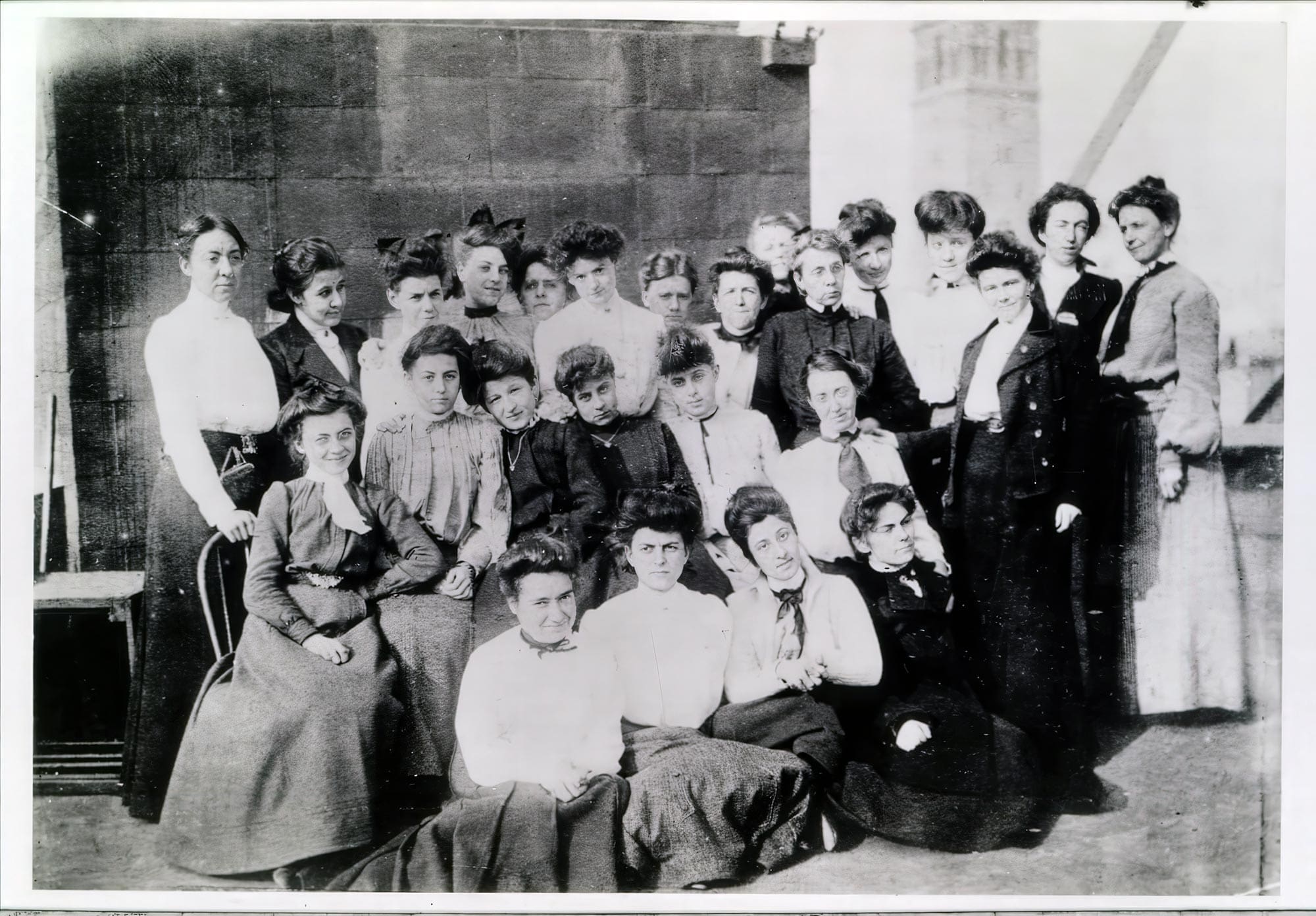
A rare gathering of Clara Driscoll and fellow “Tiffany Girls” on the roof of Tiffany Studios, circa 1904. Photo courtesy of The Charles Hosmer Morse Museum of Art. Additional restoration and resolution by RIOT.
Employed in Tiffany’s Women’s Glass Cutting Department (established 1892), they worked under unusual conditions for the era: Louis Comfort Tiffany insisted on hiring unmarried women and paid them fair wages, but required that they remain single or leave the job if they became engaged. This rule saw some of his best designers come and go multiple times as they married, widowed, or divorced. Despite their pivotal contributions, Louis Comfort Tiffany rarely publicly acknowledged these women. Over time, their identities faded from history—a historical erasure only now being rectified through scholarly sleuthing and museum research. Below, we shine a new light on each of these remarkable women, exploring their roles, artistry, and the belated recognition of their work.
Clara Driscoll: Master of Tiffany’s Lampshades
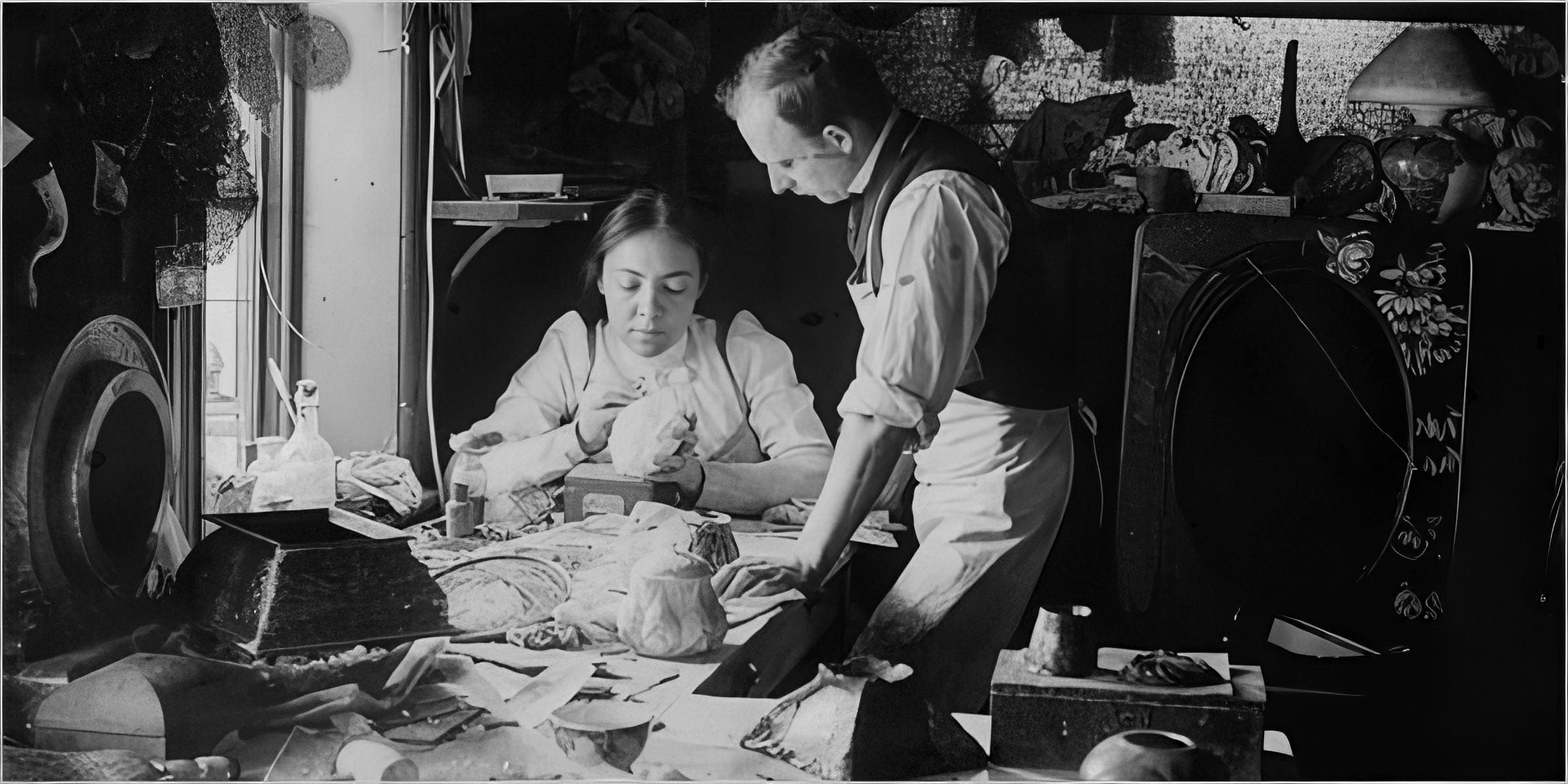
Clara Driscoll at work in 1901, guiding the design of Tiffany’s iconic stained glass and lamps. Image via Wikimedia Commons. Uprezed by RIOT.
Clara Wolcott Driscoll (1861–1944) was the creative force behind many of Tiffany Studios’ most famous stained-glass lamp designs. Hired around 1888, Driscoll eventually led the Women’s Glass Cutting Department and supervised up to 35 women in the design studio. Tiffany valued Driscoll’s keen eye for color and form; she designed more than thirty of the firm’s lamps, including the iconic Dragonfly, Wisteria, Peony, Daffodil, and Poppy lamps. In an era when work opportunities for women were scarce, Driscoll thrived as a professional artist—but only under strict conditions. Tiffany’s policy of employing only unmarried women meant Clara had to resign each time she married or got engaged. In fact, she left and returned multiple times under this rule. Even so, she spent roughly 20 years at Tiffany Studios, guiding a team that turned nature’s beauty into glass. Friends later recalled that Driscoll’s workshop was a sunlit studio filled with vibrant glass shards, a magical space where women artisans brought Tiffany’s visions to life.
Notable Contributions:
- “Dragonfly” Lamp (c. 1899): Driscoll conceived this delicate lamp with jewel-like dragonflies on iridescent wings. It became a bestseller and won a bronze medal at the 1900 Paris Exposition.
- “Wisteria” Lamp (c. 1901–1905): A cascading vine lamp composed of hundreds of glass blossoms in blues and purples. Hugely popular, it remains one of Tiffany’s most celebrated designs.
- “Peony” Lamp (c. 1905): Lush floral lamps featuring bold pink and red petals, showcasing Driscoll’s knack for arranging glass “petals” into lifelike compositions.
- Desk Sets & Fancy Goods: Beyond lamps, Clara created mosaic inkwells, jewel boxes, and other luxury items to expand Tiffany’s product line.
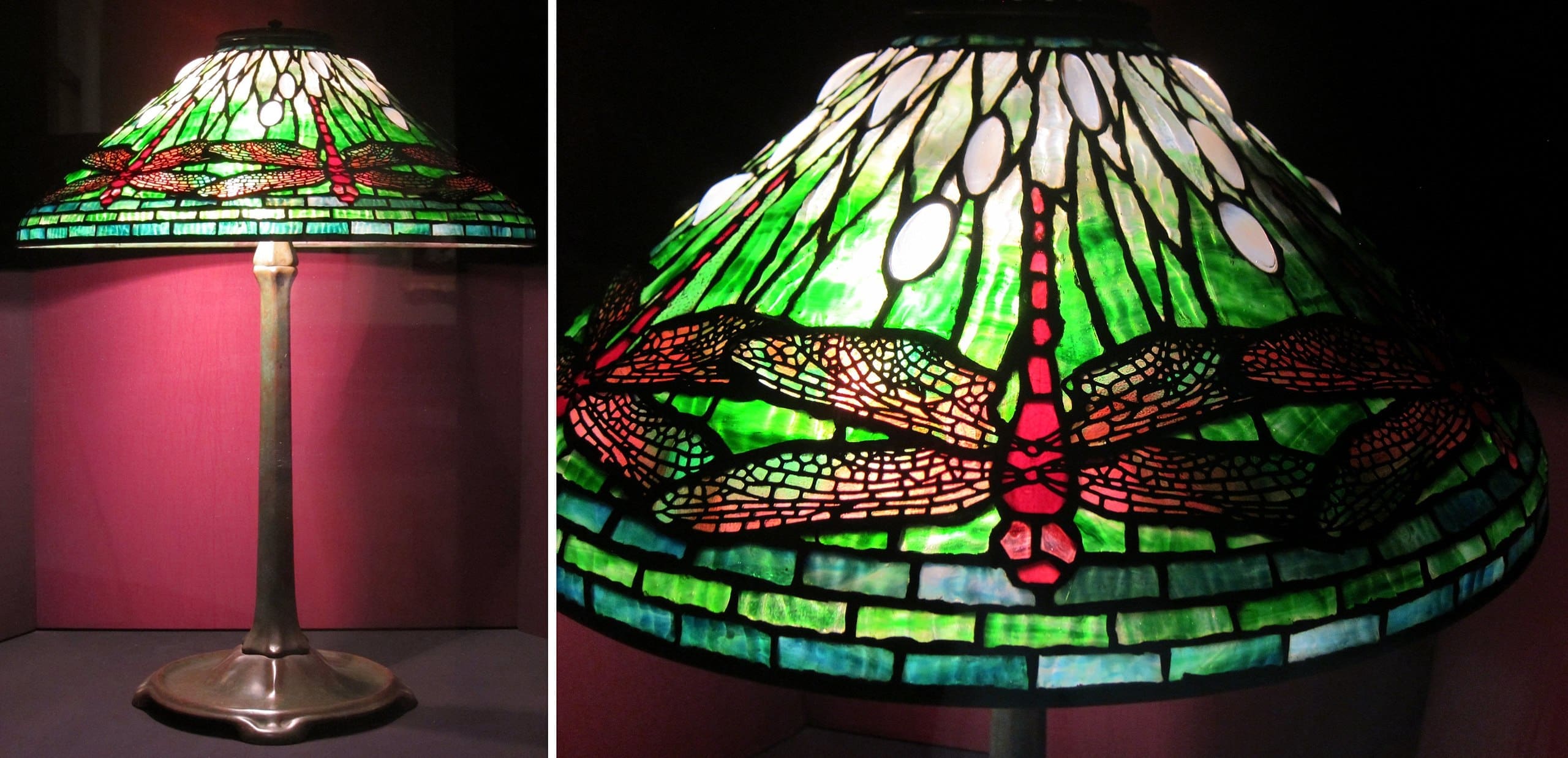
A mesmerizing Tiffany Studios “Dragonfly” lamp, alive with jewel-like greens and reds. Photo by Wmpearl, public domain.
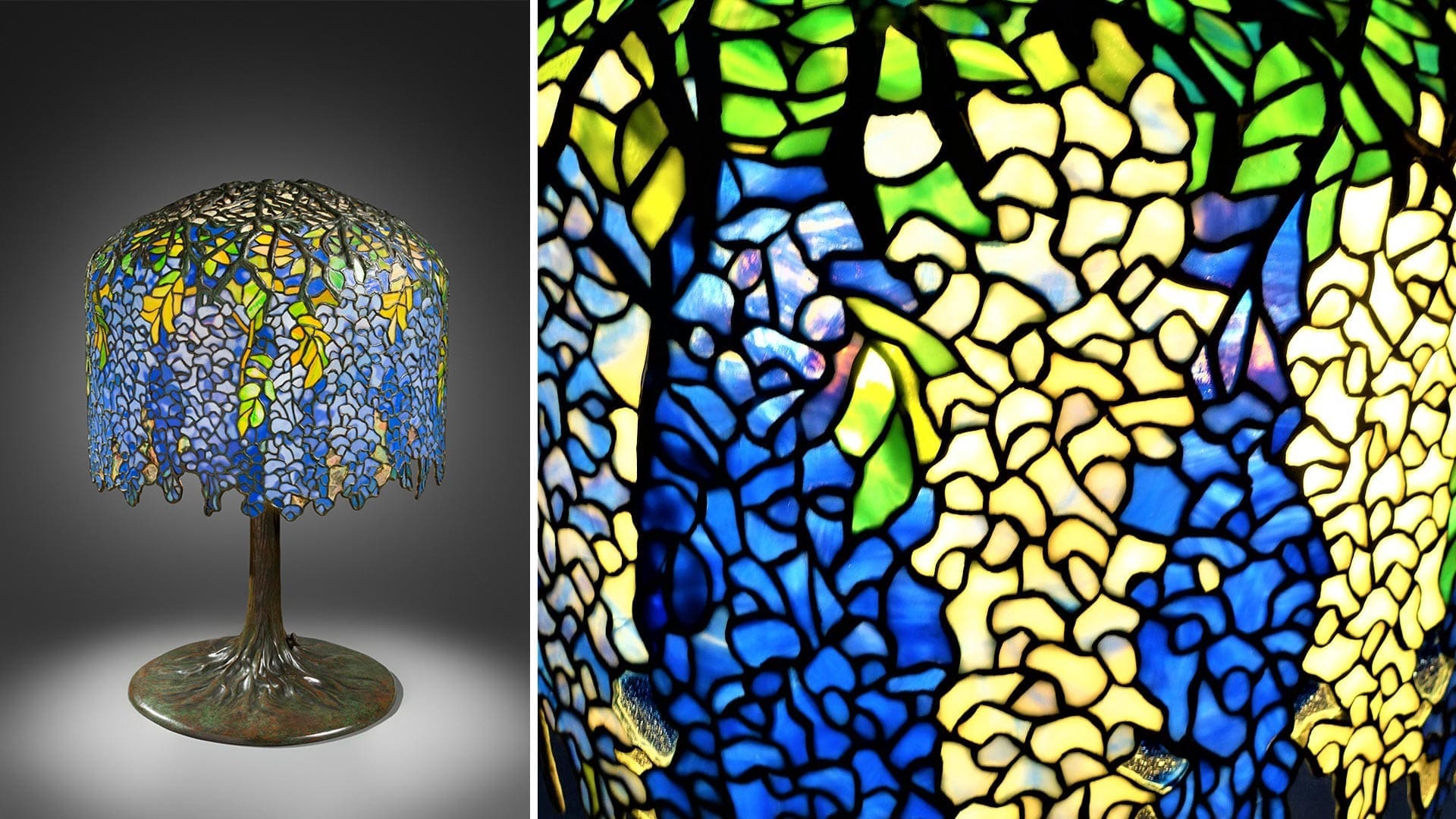
The breathtaking “Wisteria” table lamp, designed by Clara Driscoll at Tiffany Studios, featuring a cascade of stained glass blossoms in vibrant blues and purples. Image via Wikimedia Commons.
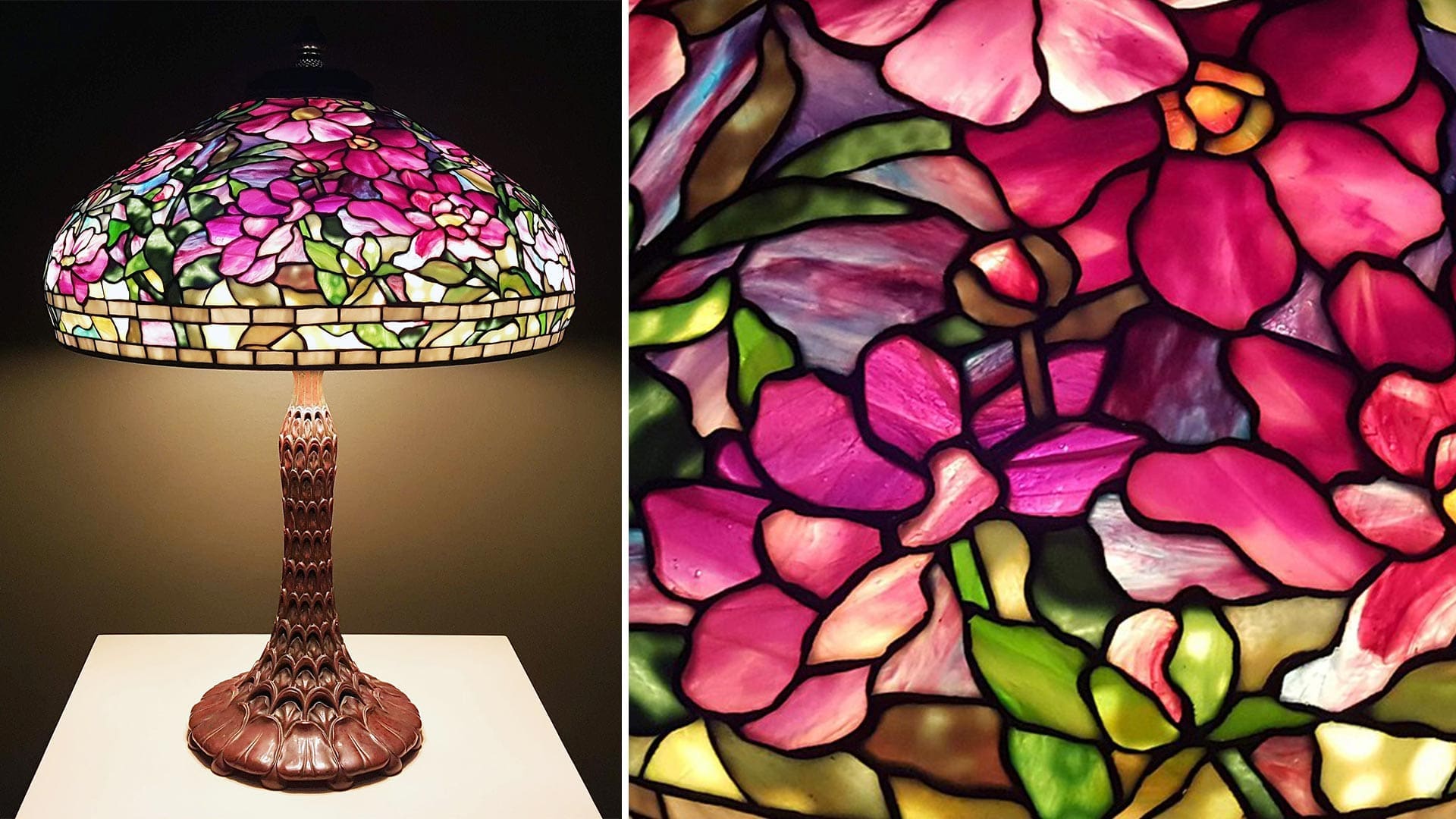
A stunning close-up of the Peony table lamp by Tiffany Studios, its pink blossoms aglow in opalescent glass. Image via Wikimedia Commons.
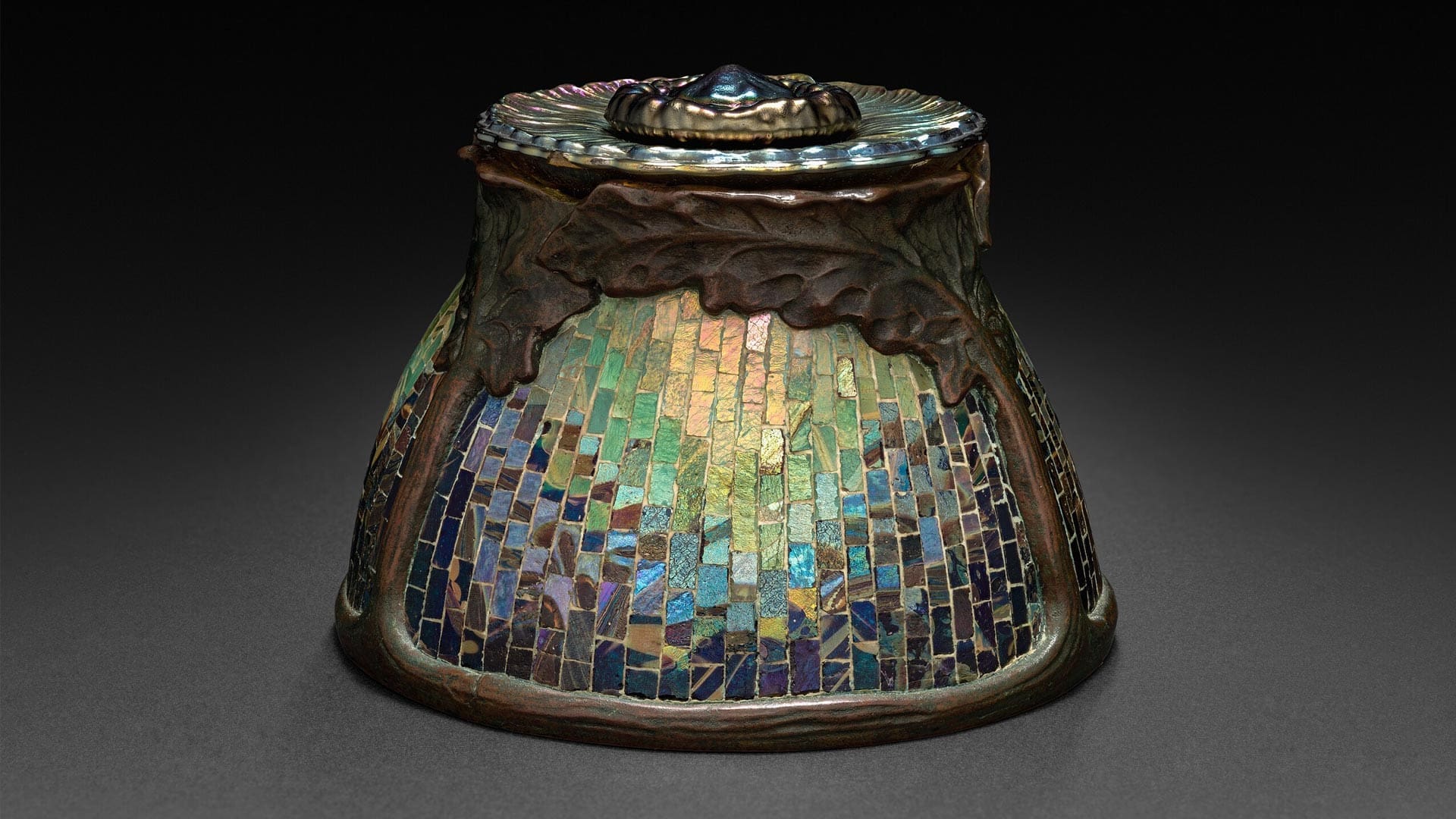
A rare Tiffany Studios inkwell attributed to Clara Wolcott Driscoll, adorned with shimmering Favrile glass mosaics and sculpted bronze oak leaves. Image via Wikimedia Commons.
Driscoll’s leadership was only fully acknowledged in the early 2000s, when researchers discovered her letters detailing lamp designs previously attributed solely to Louis ComfortTiffany. After marrying in 1909, she left the firm for good; her name then faded from history. Today, she is recognized in exhibitions such as “A New Light on Tiffany: Clara Driscoll and the Tiffany Girls.”
Agnes Northrop: Tiffany’s Landscape Window Visionary
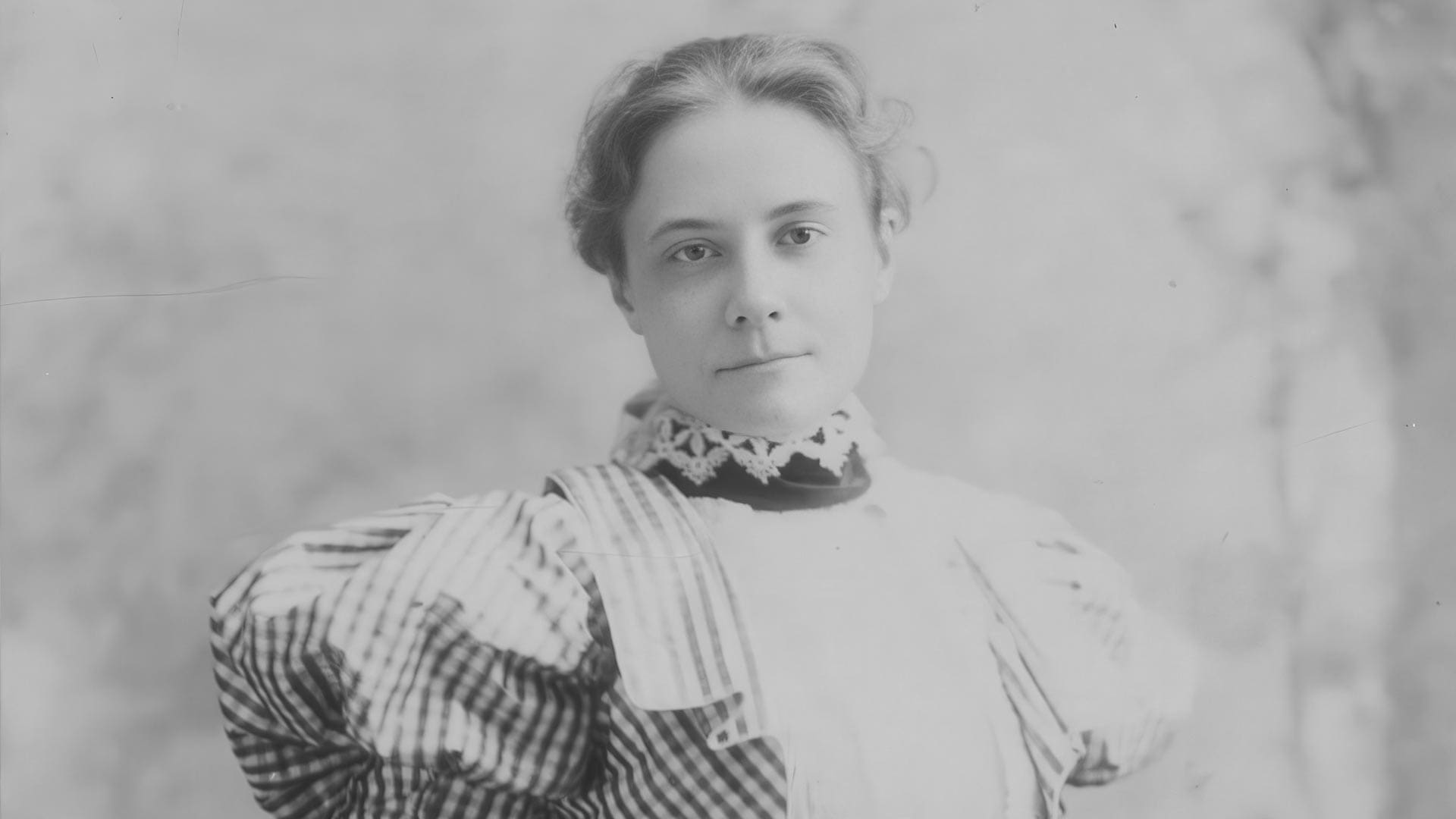
A newly upscaled and cropped portrait of Agnes Northrop, one of Tiffany Studios’ most gifted window designers, renowned for her floral and landscape creations. Original image via Wikimedia Commons.
Agnes F. Northrop (1857–1953) emerged as Tiffany Studios’ foremost stained-glass window designer, known for turning gardens and landscapes into luminous glass art. Hired in the 1880s, she stayed for half a century, never marrying and thus avoiding the studio’s marriage bar. Recognized for her exceptional talent in floral and landscape composition, Tiffany granted her an unusual level of autonomy, including a private studio. Historians later referred to her as the “chief designer of floral windows.”
Notable Contributions:
- “Magnolia” Window (1900): Displayed at the 1900 Exposition Universelle in Paris, helping Tiffany earn a grand prize.
- “Autumn Landscape” Window (c. 1923): A sweeping fall scene widely considered her masterpiece, now in the Metropolitan Museum of Art.
- Seasonal & Floral Windows: Northrop created a series depicting the Four Seasons in breathtaking detail.
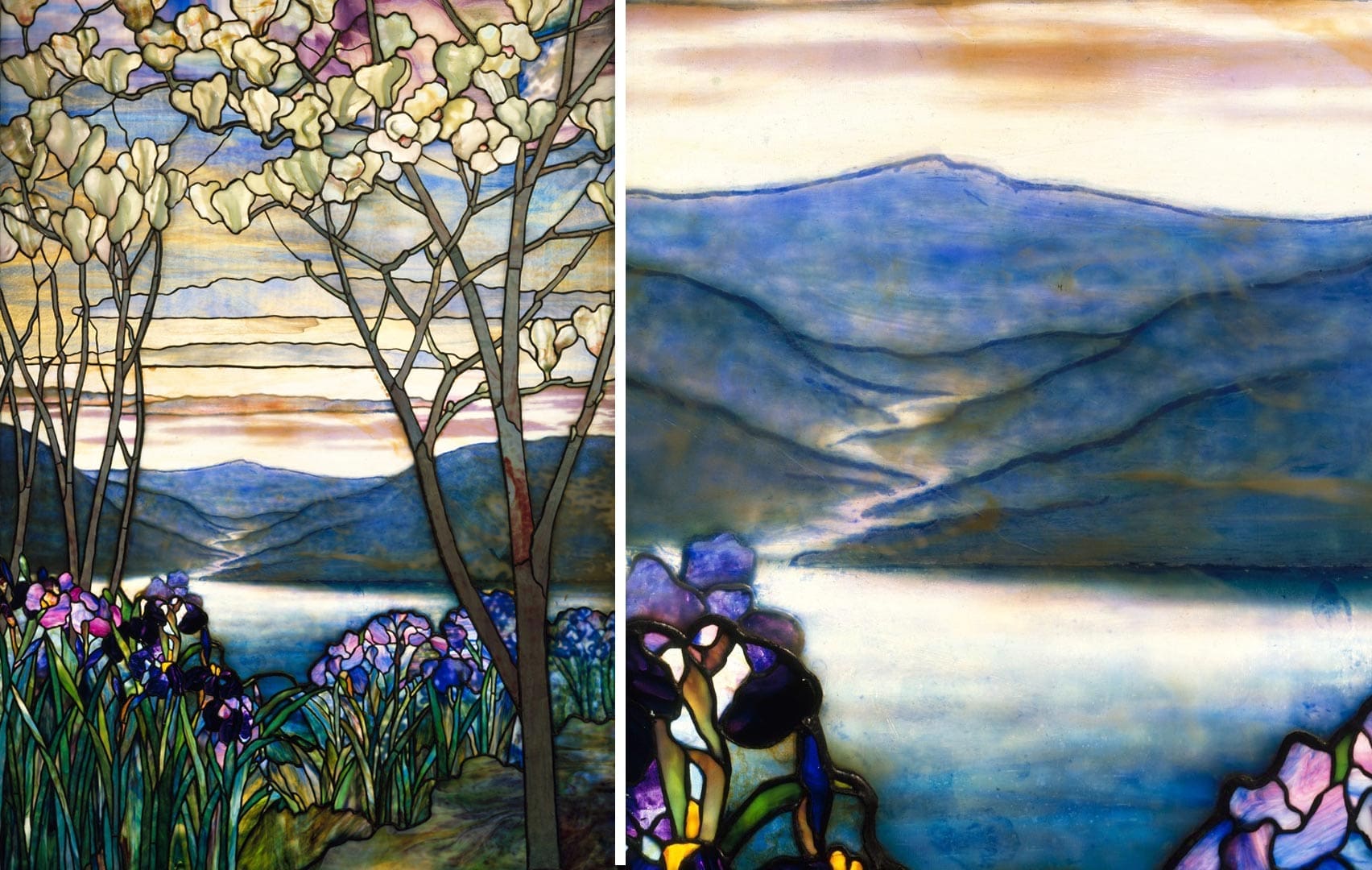
A combined view of Tiffany Studios’ “Magnolias and Irises” stained glass window (left) and a close-up of its lustrous opalescent landscape (right). Image via Wikimedia Commons.
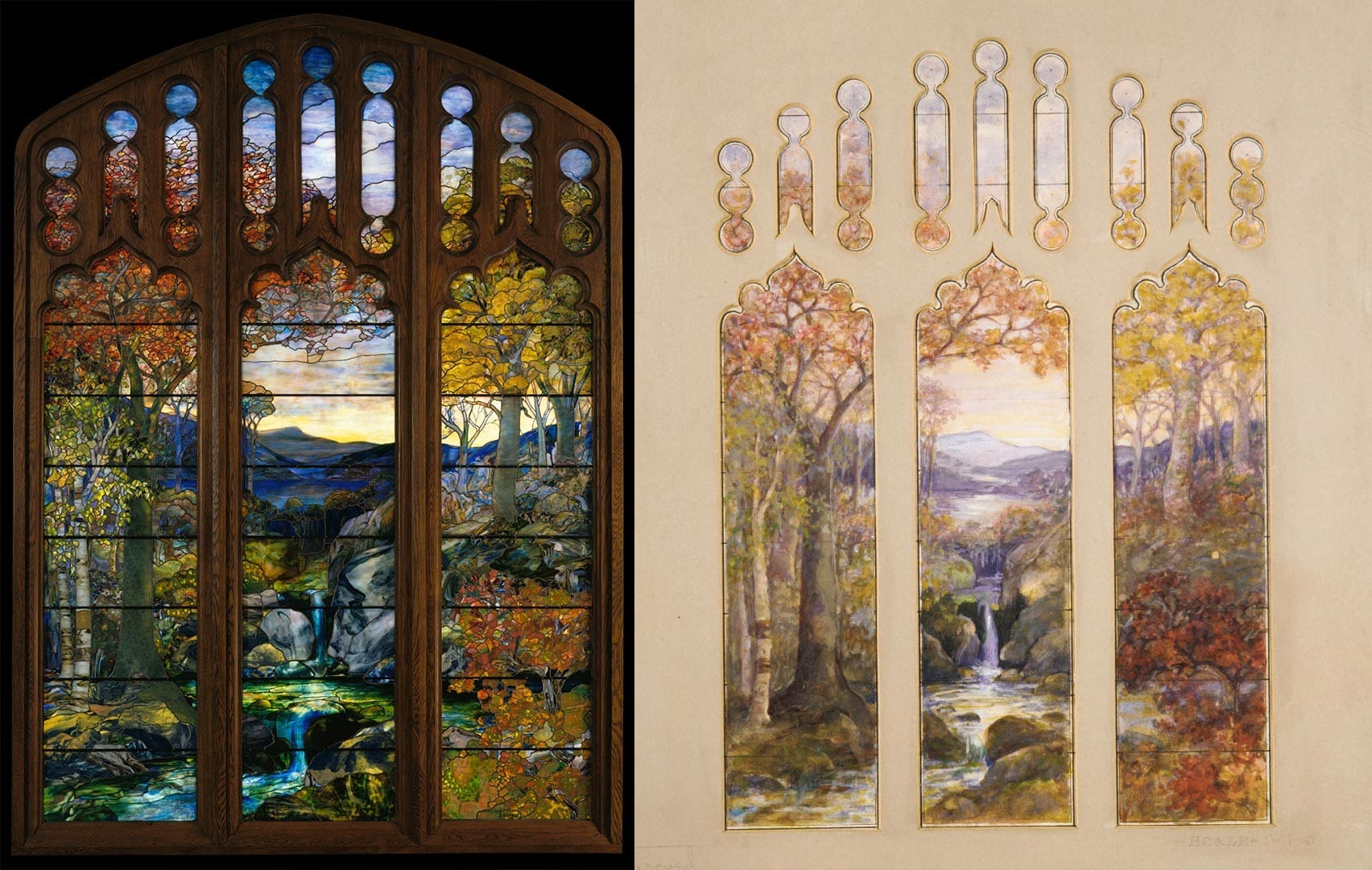
A combined look at Tiffany Studios’ “Autumn Landscape” stained glass window (left) and its watercolor design drawing (right), attributed to Agnes Northrop. Sources: Window | Design via Wikimedia Commons.
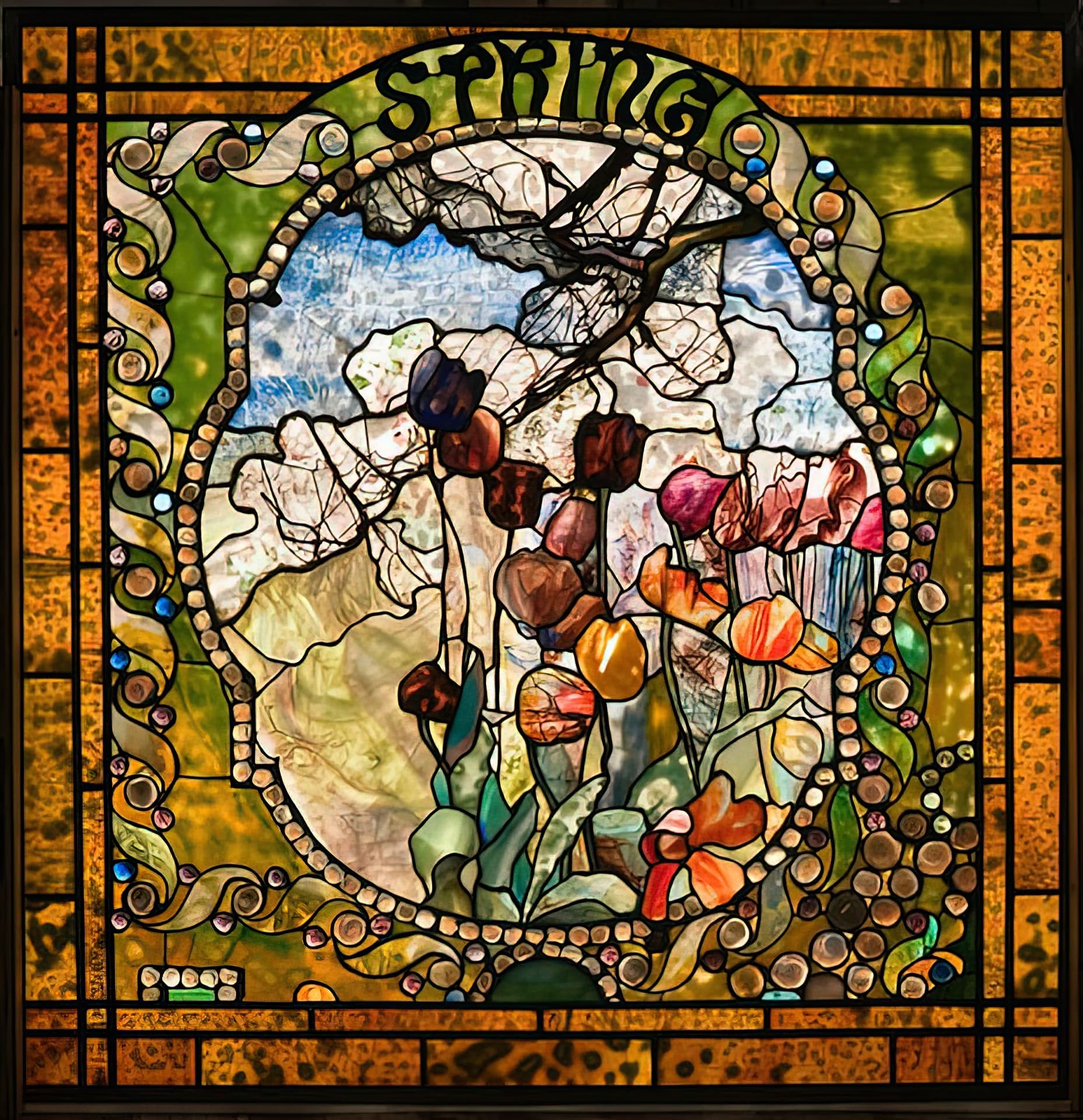
A radiant “Spring” panel from the Four Seasons leaded-glass window by Tiffany Studios, brimming with blooming tulips and ornate swirling designs. Image via Wikimedia Commons.
Though she never sought the spotlight, Northrop’s authorship of key Tiffany windows was eventually confirmed via sketches bearing her initials and internal documents. She is now celebrated for breaking the glass ceiling—literally—by designing large-scale windows typically attributed to male craftsmen of the era.
Alice Carmen Gouvy: Nature’s Poet in Glass and Enamel
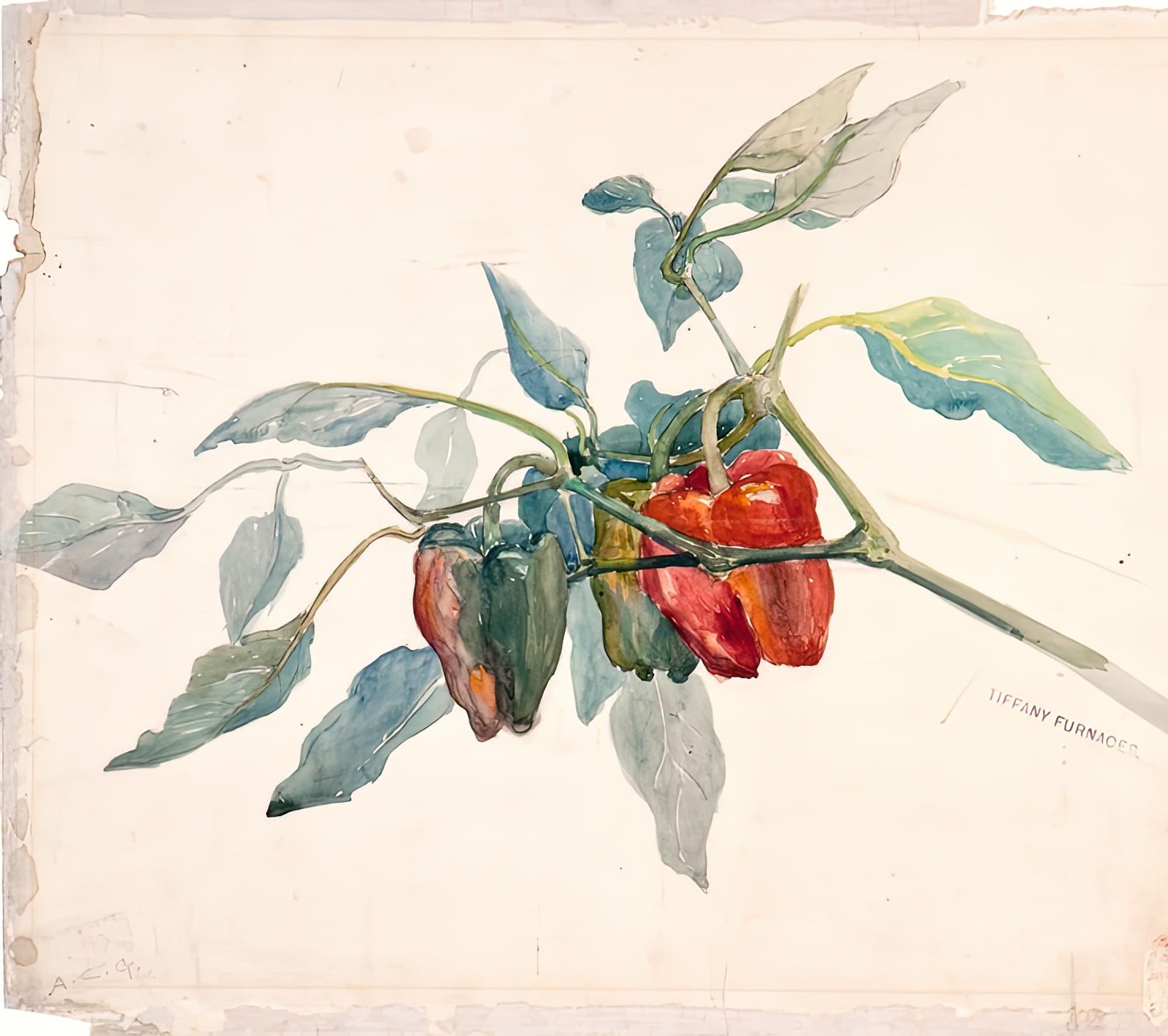
An upscaled reproduction of Alice Carmen Gouvy’s watercolor “Bell Peppers”, part of her botanical studies for Tiffany Studios. Original courtesy of the Charles Hosmer Morse Museum.
Alice Carmen Gouvy (1870–1924) was one of the “Tiffany Girls” who brought the forms of nature into Tiffany’s designs. Hired in the 1890s, she was an exceptional illustrator of flora and fauna, producing precise watercolor sketches for enamelware, mosaics, and ceramics. Along with Lillian Palmié, Gouvy worked at Laurelton Hall’s “Little Arcadia,” sketching botanical specimens from life. These renderings drove the nature-inspired look of many Favrile pottery pieces and enamel ornaments.
Notable Contributions:
- Botanical Watercolors: Detailed studies of wildflowers, pond lilies, and more, guiding Tiffany’s enamel desk sets and plaques.
- Enamel & Metalwork Designs: Gouvy co-led the enamel department, adding painterly realism to Tiffany’s glass-on-metal art.
- Favrile Pottery: Provided watercolor patterns, including whimsical vegetable and fruit motifs.
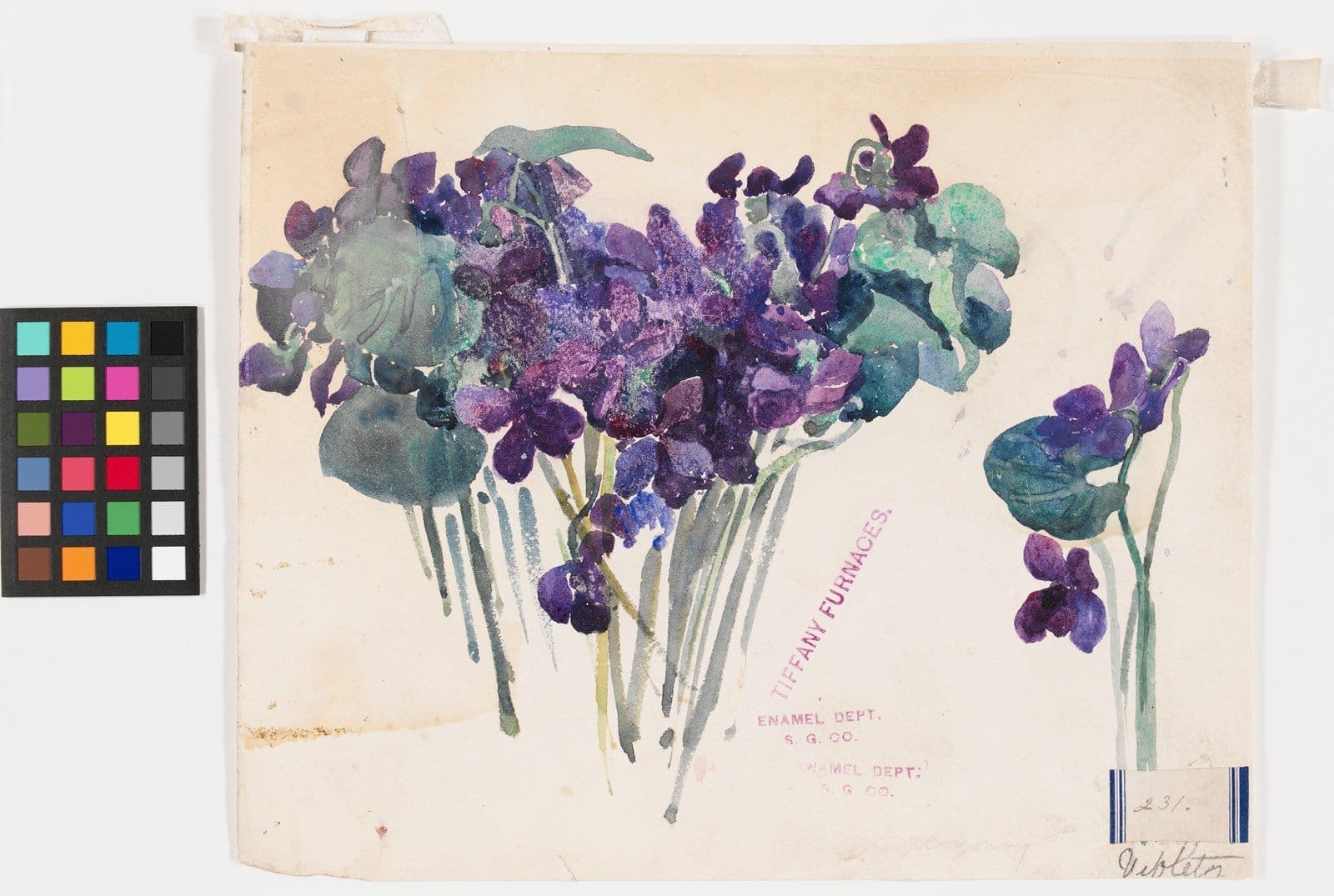
A delicate watercolor titled “Violets”, potentially linked to Tiffany’s Enamel or Design Department, reflecting the era’s fascination with botanical subjects. Image via Wikimedia Commons.
Her genius remained hidden until museum exhibitions highlighted Gouvy’s sketches. Her friend Clara Driscoll’s letters shed further light on Gouvy’s role in shaping the studio’s nature-based aesthetic. Within, she reveals a deep admiration for Gouvy’s eye and hints at the creative spark she brought to Tiffany’s studios:
“Miss Gouvy is a joy. She sketches the vines from life with such truth that I hardly need to correct a line. Every leaf and tendril shines with the promise of color. We spoke again this morning of how Mr. Tiffany might use her studies for enameled pieces—my heart leaps at her excitement and skill.”
— Clara Driscoll (c. 1902)
It was precisely this harmony of scientific observation and artistic verve that made Gouvy invaluable: her watercolors flowed seamlessly into Tiffany’s enamel designs, Favrile pottery, and mosaic motifs.
Lillian Palmié: Enamel Alchemist of Tiffany Studios
Lillian A. Palmié (1873–1944) co-headed Tiffany’s enamel department alongside Gouvy. Known for her “chemist’s curiosity,” Palmié ceaselessly experimented with glass powders and metal foils to create brilliant color blends. She turned Gouvy’s watercolor designs into viable enamel plaques and jewelry, ensuring intricate motifs survived multiple firings. Palmié also aided in decorating Favrile pottery and participated in the “Little Arcadia” nature studies at Laurelton Hall.
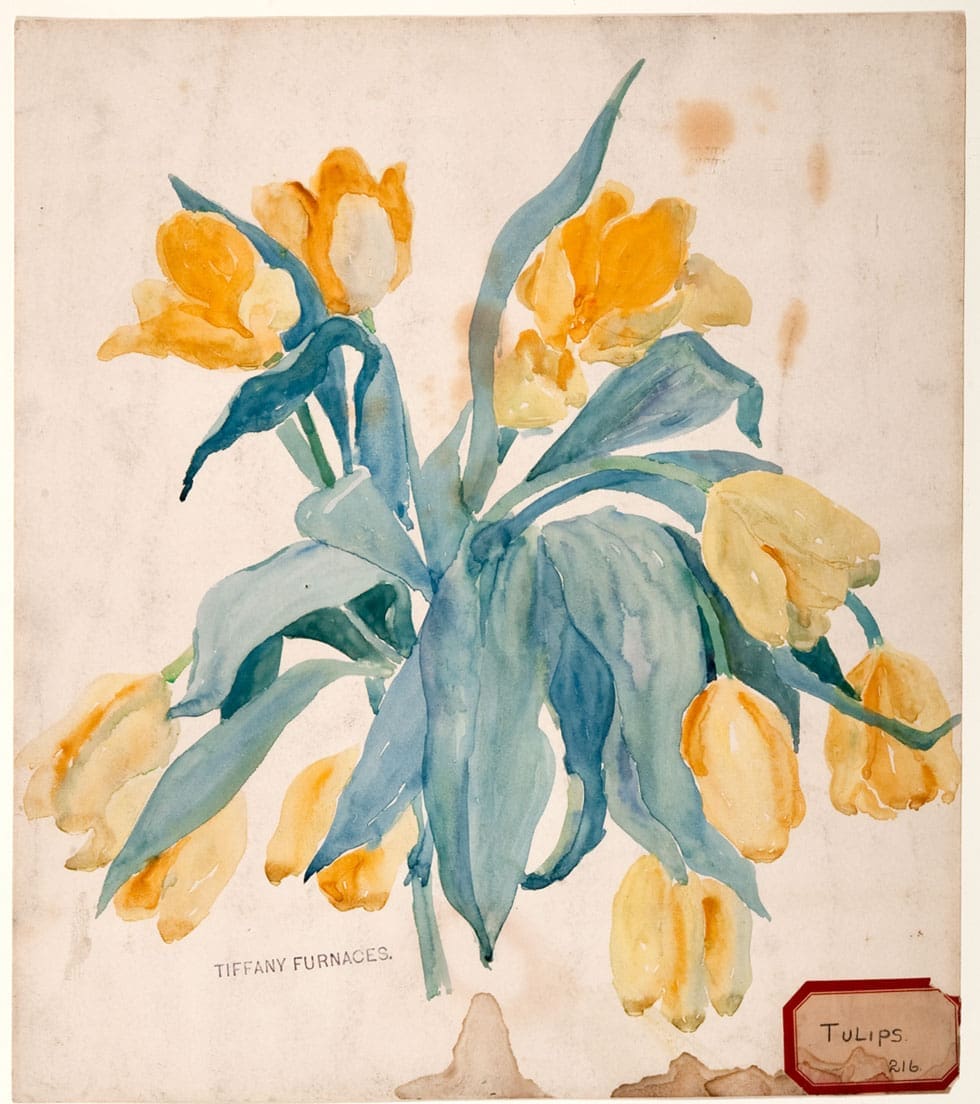
An enchanting watercolor titled “Tulips” by Lillian Palmié, a key artist in Tiffany Studios’ enamel and design departments. Image courtesy of the Charles Hosmer Morse Museum of American Art.
Notable Contributions:
- Nature-Inspired Enamelware: Oversaw designs of sea-themed plaques and aquatic motifs in glowing enamel.
- Favrile Pottery Decorations: Collaborated on botanical ceramics that merged artistry and technical knowledge.
- Design Studies & Sketches: Integrated her and Gouvy’s garden observations into Tiffany’s mosaic work.
Palmié’s legacy lay dormant until modern scholarship matched her name to enamel masterpieces once attributed solely to “Tiffany Studios.” She embodied the bridge between art and science that made Tiffany’s experimental lines so distinctive.
Julia Munson: Tiffany’s First Jewelry Mastermind
Julia Munson (1875–1971) served as head of Tiffany’s Art Jewelry department from about 1899 to 1914, guiding the design of necklaces, brooches, and ornaments that fused metals, gems, and enamel. Working closely with Louis Comfort Tiffany, she translated his rough sketches into fully realized pieces, overseeing the master jewelers who executed them. Under Munson’s leadership, Tiffany’s jewelry gained a reputation for blending natural motifs—peacock feathers, dragonflies, floral vines—with cutting-edge craftsmanship.
One of the crowning achievements under Munson’s direction was the now-legendary The Medusa pendant. Designed between 1902 and 1904, this mesmerizing jewel combines opals, garnets, and gold filigree to evoke the sinuous grace of a bioluminescent jellyfish. Long lost to the public eye, The Medusa recently reemerged, capturing new attention when Tiffany & Co. reacquired it for their archives. We’ve personally shot footage and detailed images of this pendant—an experience that underscores just how arresting Munson’s artistry remains over a century later.
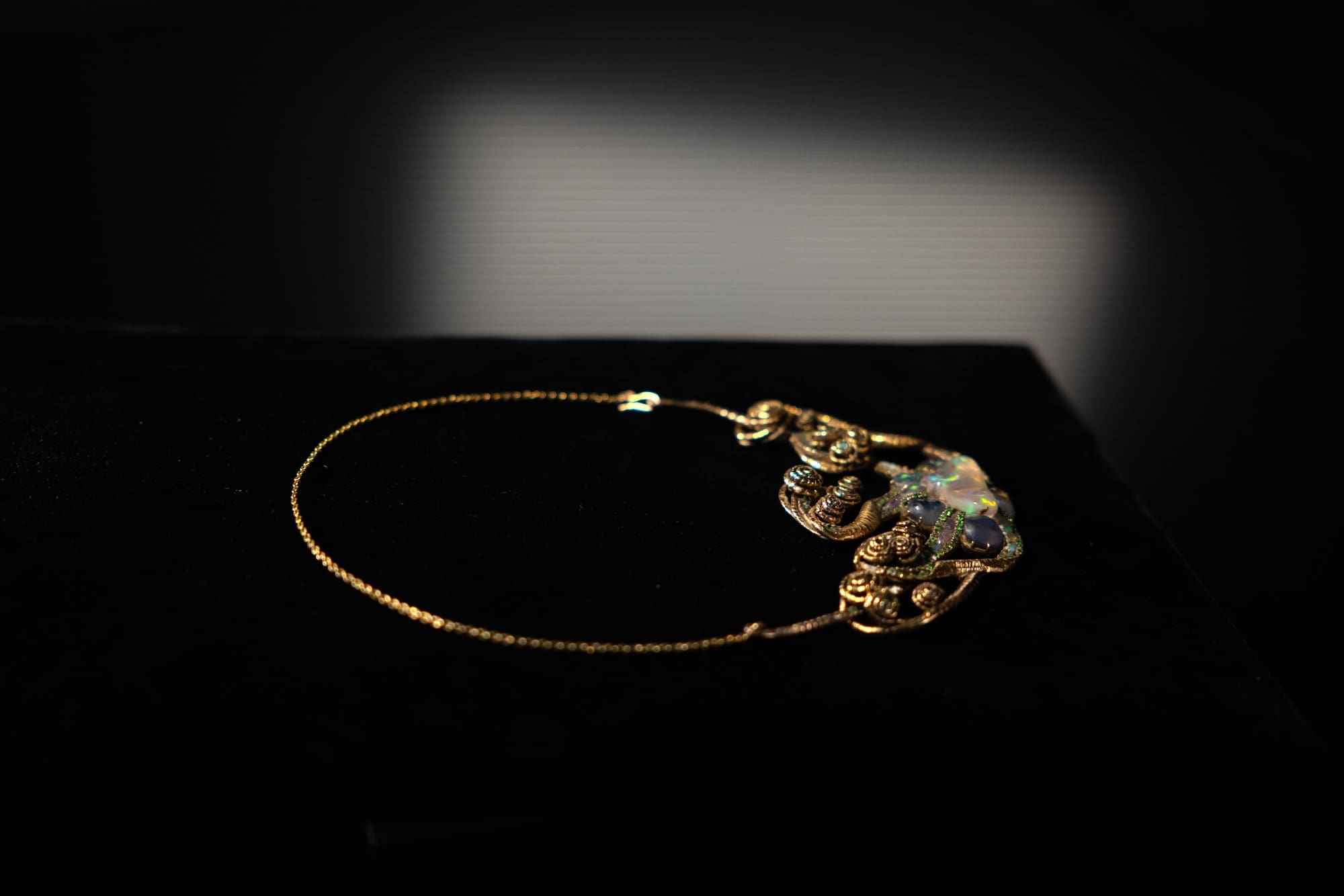
A moment suspended in time: The Medusa pendant, its opals glowing like captured fire, resting against the darkness. This Louis Comfort Tiffany masterpiece, lost for a century, now reclaims its legend. Photo by Adrian Nina.
Despite the groundbreaking designs produced under her watch—including prized exhibition jewels for the Paris Exposition—Munson’s name stayed in the shadows, attributed simply to “Tiffany & Co.” Her tenure ended in 1914 when she departed upon marriage, giving way to Meta Overbeck. Only decades later did oral histories and archival records confirm Munson’s role as the first director of Tiffany’s jewelry department, establishing the creative vision that would enchant collectors for generations.
Notable Contributions:
- Exhibition Jewels (1900–1904): Munson’s designs garnered acclaim at the Paris Exposition and other fairs, though publicly credited to Tiffany.
- Peridot Grapevine Brooch: A gold, enamel, and peridot piece exemplifying Munson’s preference for organic forms.
- Mixed-Metal Desk Pieces: Oversaw lavish inkwells, caskets, and accessories bridging jewelry and decorative arts.
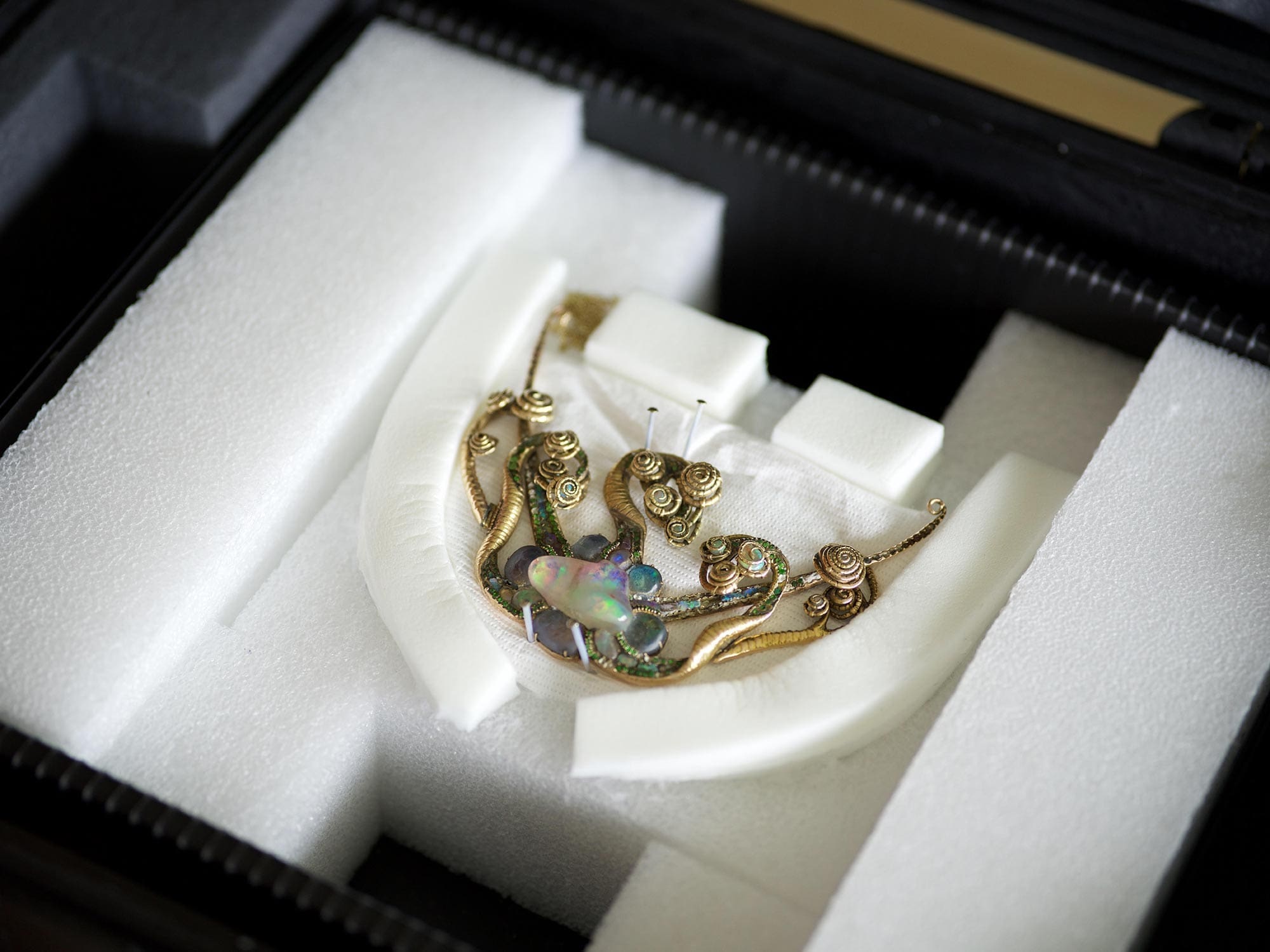
The first official image of Louis Comfort Tiffany’s legendary Medusa pendant after its acquisition by Tiffany & Co., resting in its archival case. Photo by Adrian Nina.
Meta Overbeck: Keeper of Tiffany’s Jewelry Flame
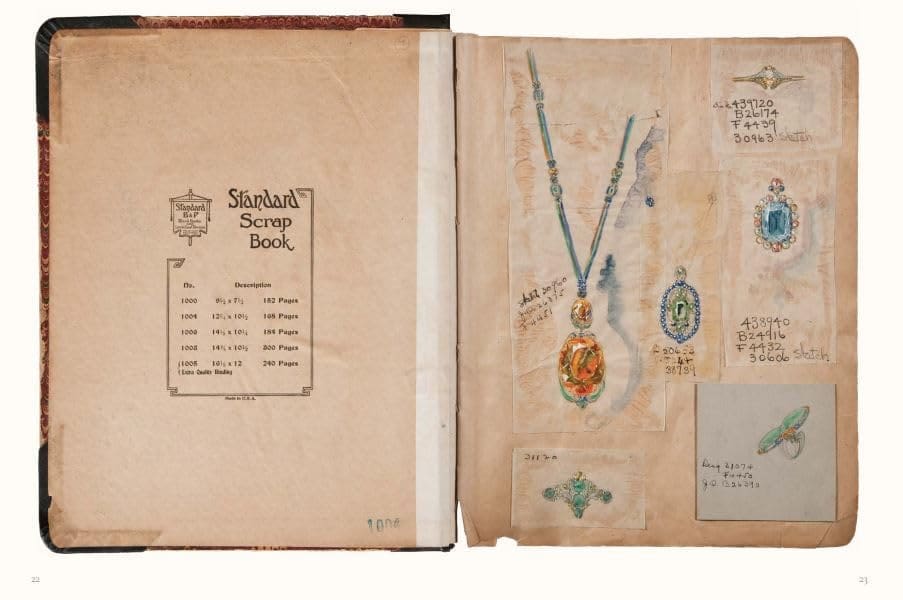
A rare glimpse into Meta Overbeck’s design book for Louis C. Tiffany Art Jewelry, featuring hand-sketched pendant and ring concepts. View or purchase the full edition from the Hillwood Museum Store.
Margreta “Meta” Katherine Overbeck (1879–1956) succeeded Munson as jewelry director from 1914 until Tiffany Studios closed in 1932. Overbeck maintained the studio’s botanical inspirations while adapting to evolving tastes in the 1910s and 1920s. Her design sketchbook survives, revealing brooches and pendants adorned with orchids, ginkgo leaves, and peacock feathers—miniature reflections of Tiffany’s larger art-nouveau style.
Notable Contributions:
- Meta Overbeck’s Design Book: A rare watercolor collection of her jewelry concepts—an invaluable window into Tiffany’s creative process.
- Art Nouveau to Jazz Age Jewelry: Guided the transition from lavish floral forms to more streamlined modern designs in the 1920s.
- Two-Decade Leadership: Ran the jewelry department until the Great Depression forced Tiffany Studios’ closure.
Overbeck remained invisible to the public until museums and archivists rediscovered her sketches, confirming her central role. Her story illustrates the quiet power of women who sustained Tiffany’s artistic vision late into his career.
Under the Glass Ceiling: Working Conditions and Challenges
All Tiffany Girls shared certain experiences in Tiffany’s employ. On one hand, Louis Comfort Tiffany hired women for artistic roles and paid them reasonably, an unusual stance for the 1890s. On the other hand, he enforced a rule barring married women from working at his studio. If a Tiffany Girl wed, she had to resign—no exceptions. This policy caused talented designers like Clara Driscoll and Julia Munson to depart upon marriage, interrupting their careers. Meanwhile, those who never married (Agnes Northrop, Meta Overbeck) stayed longer.
Male workers sometimes resented the women’s presence; union strikes protested “women displacing men” in glass cutting. Yet the Women’s Glass Cutting Department thrived, forming a unique sisterhood of single professional women—an uncommon dynamic in the Gilded Age. They often worked long hours to meet deadlines for major commissions, but credit went solely to “Tiffany Studios.” Lamps, windows, and jewelry bore Tiffany’s name alone, consistent with many art manufacturing firms of the era. By the time Tiffany Studios folded in 1932, the women’s identities were largely lost to history.
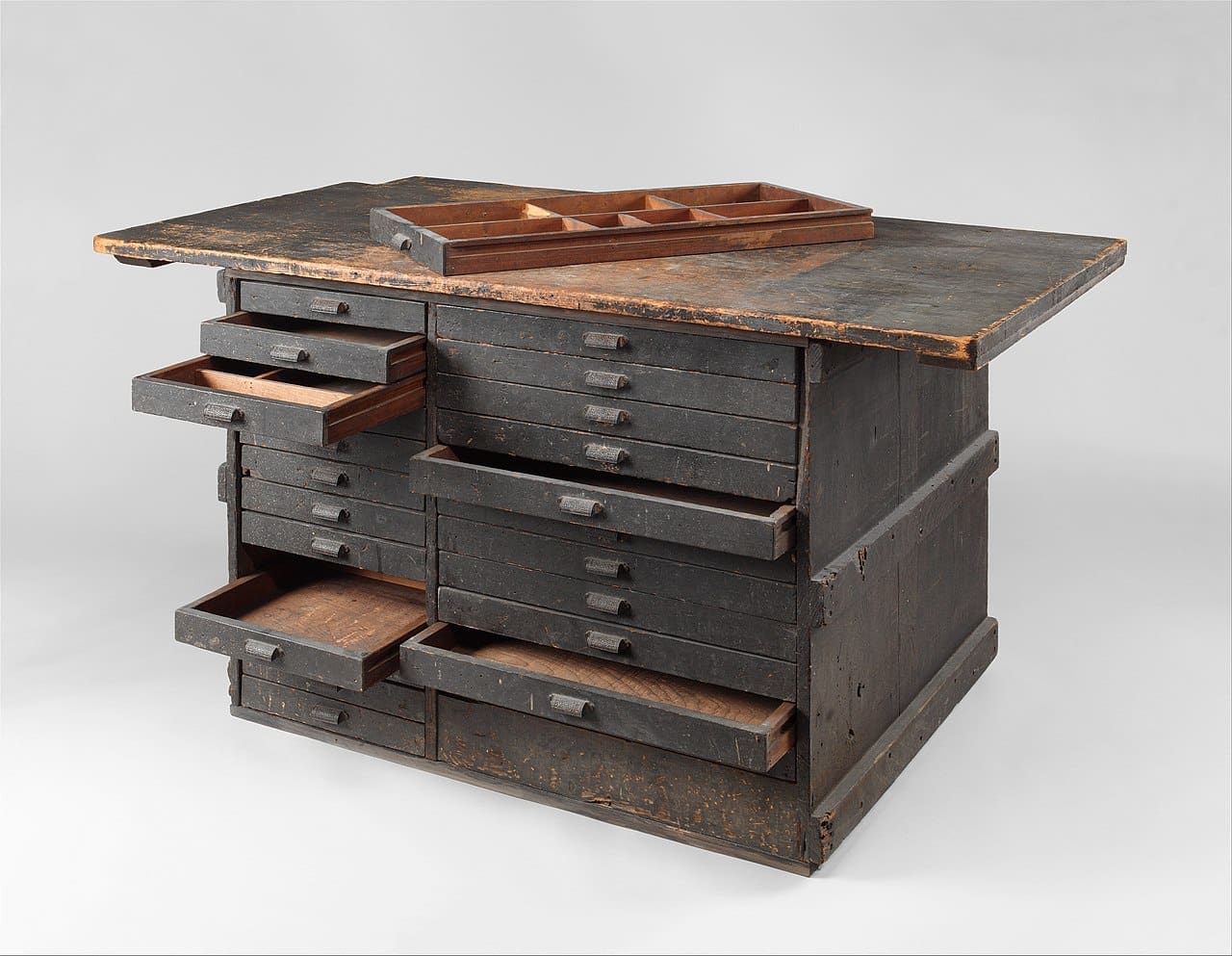
A versatile work bench used at Tiffany Studios, complete with drawers and compartments for glass and tools.
Photo by The Metropolitan Museum of Art, CC0 1.0 via Wikimedia Commons.
Rediscovery: Reclaiming Their Place in History
For decades, art histories mentioned only Louis Comfort Tiffany. Yet clues about female designers emerged through scattered documents, sketches, and a few interviews. The turning point came in the early 2000s with the discovery of Clara Driscoll’s letters. These revealed that many iconic Tiffany lamps were in fact conceived by Driscoll and her team. Subsequent research identified the other “Tiffany Girls,” matching their names to design drawings, factory records, and oral histories.
Now museums are updating labels on lamps, windows, and jewelry—acknowledging names like Driscoll, Northrop, Gouvy, Palmié, Munson, Overbeck. In doing so, we better appreciate the collaborative nature of Tiffany Studios, where women designers played a central role in shaping some of America’s most beloved decorative arts.
Recognizing these extraordinary women enriches the cultural narrative, revealing that Tiffany’s brilliance was not solitary but illuminated by the skill and vision of the Tiffany Girls. Their stories, once hidden, stand as a testament to perseverance, talent, and the quiet power of women who refused to remain mere footnotes.
References
- Brooklyn Museum label for Tiffany “Dragonfly” Lamp, now attributed to Clara Driscoll.
- Encyclopedia of Cleveland History – Entry on Clara Driscoll (glass designer).
- PBS Antiques Roadshow – “Who Were the ‘Tiffany Girls’?” discussing marriage rule.
- Various ceramics.org articles – highlighting Clara Driscoll’s lamp designs.
- Museum notes on Agnes Northrop’s Magnolia window at the 1900 Exposition Universelle, discovered in museum archives.
- Kingsbridge Historical Society – “Celebrating Agnes Northrop” referencing her private studio.
- Corning Museum of Glass – “Tiffany Treasures: Design Drawings by Alice Gouvy and Lillian Palmié.”
- Antiques and The Arts Weekly – Tiffany Glass features referencing Gouvy, Palmié, Munson, etc.
- Journal of Antiques – “The Tiffany Girls: Under the Glass Ceiling” (Julia Munson’s work in jewelry).
- Archives from The Met Museum – Overbeck’s leadership of Tiffany jewelry (1914–1932).
- Hillwood Museum – “Meta Overbeck’s Design Book” published in facsimile.
- New-York Historical Society – “A New Light on Tiffany: Clara Driscoll and the Tiffany Girls.”

